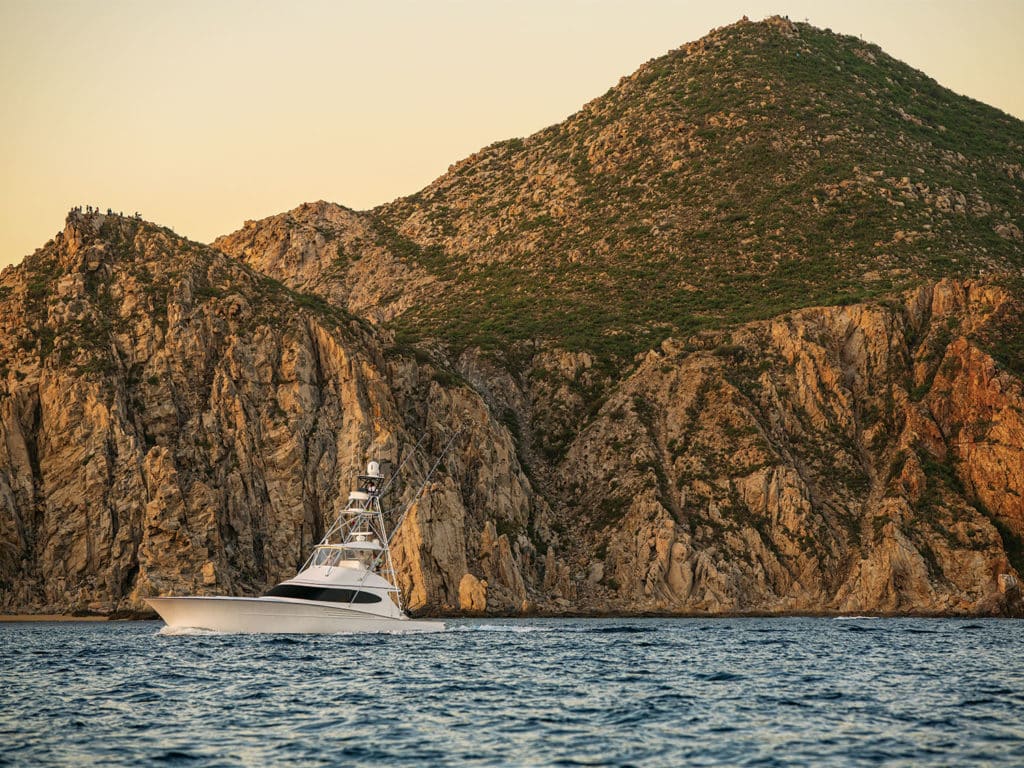
A strong tropical storm brushed past the southern tip of the Baja Peninsula in October 2019, causing some major disruption in the bustling resort town of Cabo San Lucas, Mexico. After hearing of the great striped marlin fishing in the weeks prior to their arrival, Bob Faith—owner of the 62-foot Bayliss Game Changer—and his friends Steve Leasure and Dale Lackey instead found themselves stuck in the slip for days, watching it rain. The port was closed. For big trips like these, boat owners often make their plans a year or more in advance: They buy the tackle and bait, put the proper spares on board, reserve the slip, set up the crew, and arrange shipping or plan the passage of the boat to navigate the 1,500 or so miles from the East Coast through the Panama Canal, then another 2,150 more miles up to Cabo. Then Mother Nature reminds you who is really in control, and you’re stuck in a tropical depression. That was the situation facing Capt. Ben Polk after arriving with Game Changer in Mexico for Faith’s inaugural trip, and it wasn’t off to a great start.
Polk finally brought the engines to life the morning of October 15, shortly after Cabo San Lucas port captain Jose Beltran allowed vessels to depart. Polk and his eager crew left the slip around 7:30 a.m., winding through the busy marina basin, past the barking sea lions and then the distinctive rock pinnacle called El Arco just outside the harbor. After weaving his way through the largest charter fleet in the Pacific, which was also understandably eager to get back out on the water, Polk pushed up the throttles and settled into a 38-knot cruise. The cliffs of Pedregal were soon replaced by the majestic Sierra de la Laguna mountain range looking down on them from the east as they headed northwest, on a course to what was eventually destined to be the greatest day of dead-bait striped marlin fishing any team has ever seen. But it didn’t start off that way.
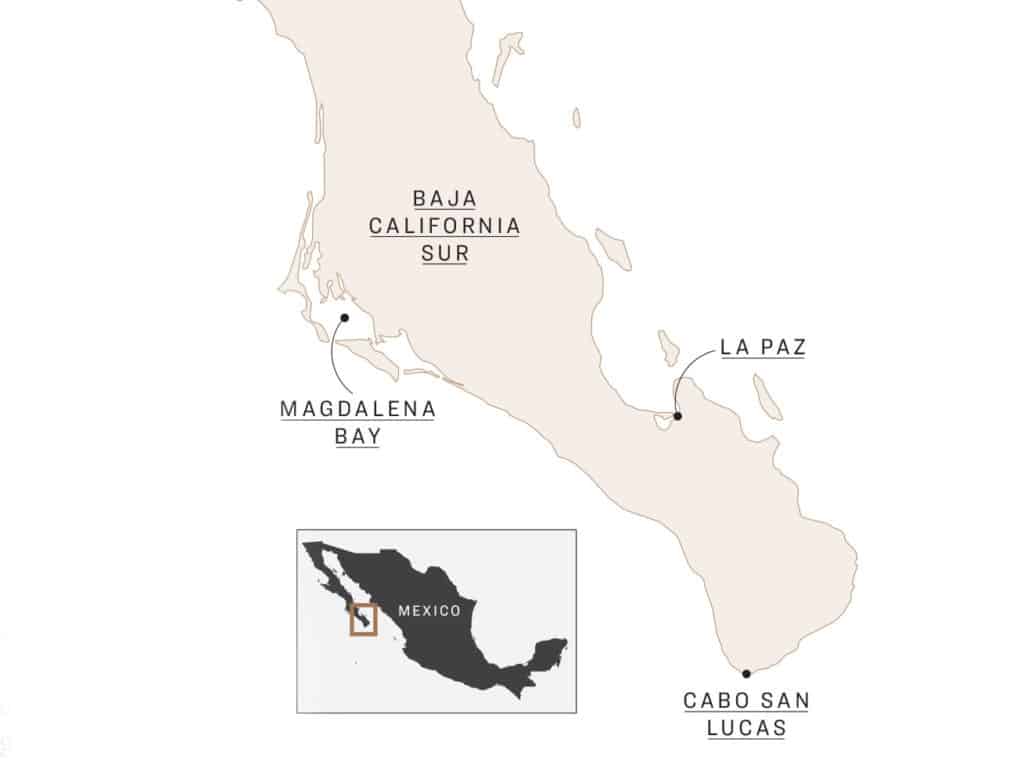
From Zeros to Heroes
The original plan was to head to the Finger Bank for a day of fishing and then chug overnight north to Magdalena Bay, where they wanted to spend a few days enjoying that fabled fishery. The group departed Cabo with their main goal of the trip to beat the high release number of 52 striped marlin that Game Changer had tallied on a recent trip just prior to the storm’s arrival. It also gave Polk and mate Hovey Aiken a chance to synchronize with two new crewmembers: Jamie LaGrone from Costa Rica and Tomason Diaz, a Cabo native. This trip would be everyone’s first to Mag Bay, and since they did not know exactly what to expect, they were prepared for plenty of action: 10 cases of ballyhoo, 800 snelled circle-hook leaders, 16 Shimano Talica BFC 20s and 25s spooled with Sufix 25-pound-test line, and one precious flat of rigged ballyhoo in the freezer, plus another 200 ready to go in the bait cooler.
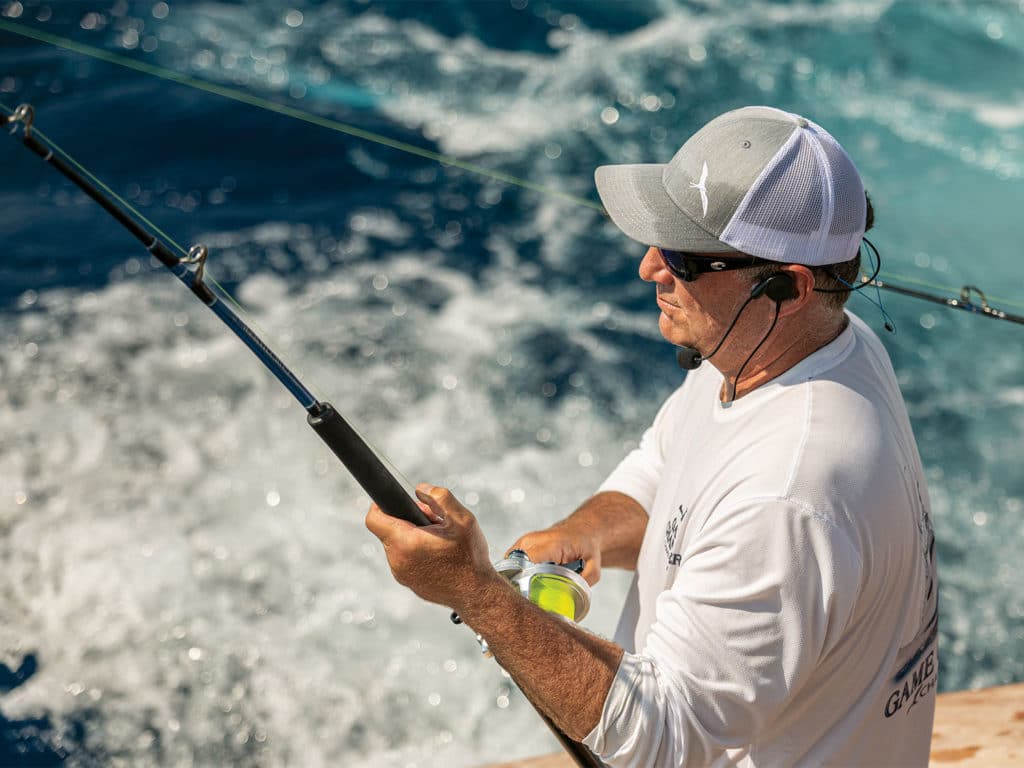
When the conditions are right, the 52-mile run from Cabo to the Finger Bank creates a drop of a few degrees in the air temperature as you approach the bank, due to the cooler water currents from the northwest and the breeze that flows across it to the southeast. Sea-surface temperatures of 80 degrees or more near the mainland usually cool down to the mid to upper 70s offshore during that time of year. These are the optimal temperatures for the bait shoals necessary to attract and support large numbers of striped marlin, causing them to aggregate along the southern Baja Peninsula. This sensation of the air temp noticeably dropping as you head north usually means something amazing is about to happen at the bank, but it wasn’t in the cards for Polk that day.
The Game Changer team worked the Finger Bank for a while with zero results, in the same area they had set their personal-best release numbers before the storm. Polk was not seeing the bait on his sounder, or the flocks of birds that had been aggressively working the area as they had the week before. This was surely not a good way to start their first trip out of Cabo with the boss and his friends, so Polk decided to reel in the lines and try a different area. They ran to the Potato Bank, which was more than 50 miles to the northwest. Polk was now in new, unfamiliar territory; the Finger Bank was the farthest north out of Cabo San Lucas he had fished so far in his career.
Watch: A swimming Spanish mackerel is an outstanding marlin bait. Learn to rig one here.
After arriving at the new spot, they picked away at the striped marlin, releasing nine in a few hours of fishing. This too was not the result they were hoping for. Where had all the marlin gone? Had the rain and wind somehow driven the fish away? Even worse, were they going to have to hear how great it was last week in Mag Bay when they returned because they had missed the action? Worried and not knowing if the fish were still going to be around, they picked up and ran the remaining 45 miles or so up to the area where other boats had reported amazing fishing prior to the storm. As they arrived about 20 miles from Mag Bay, Polk began to see a few birds working over bait, so he figured they would give it an hour or so before dark to try to locate a starting point for the next day since they planned to head inshore and anchor up for the night while it was still light enough to see.
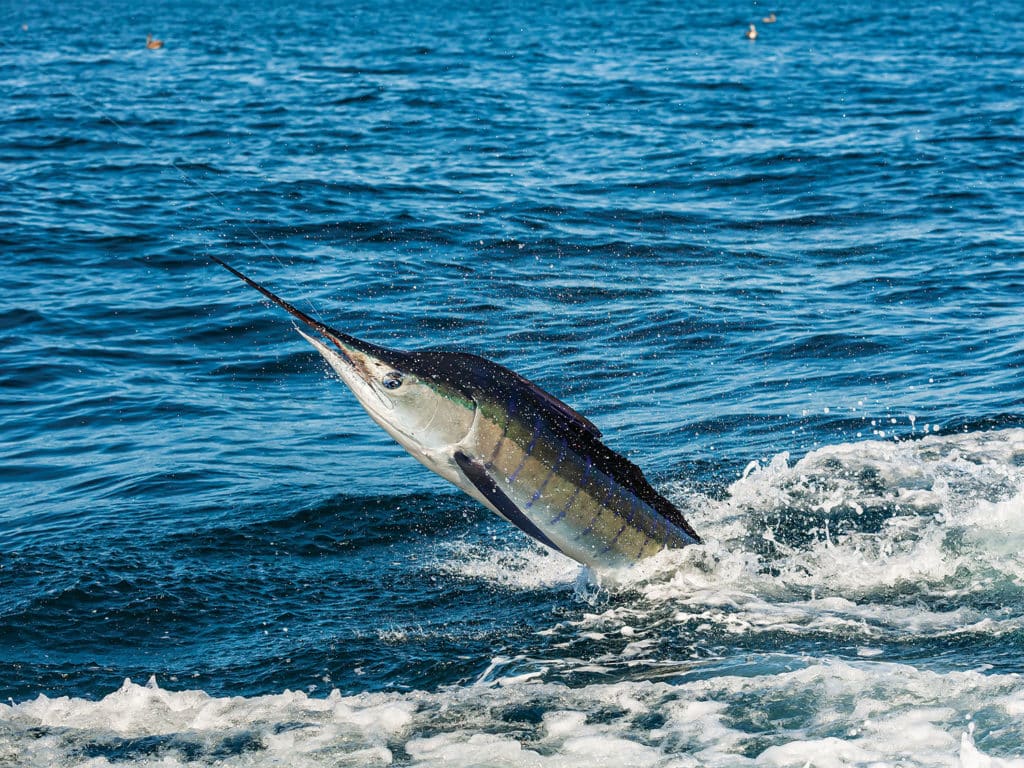
It Begins
After the bumpy ride, Polk pulled back the throttles and then dropped the outriggers. Just as he grabbed the freshwater hose to spray off the boat, he heard, “Hooked up,” then looked down to see his team had already started hooking what would turn into a quintuple of striped marlin. Over the next three hours, the team released 81 striped marlin before the sun set. They chugged 10 miles into the anchorage at Tasco in complete darkness and finally dropped the hook at 9:00 p.m. Their mission was accomplished, but what would tomorrow bring?
That evening, LaGrone and Aiken rigged 300 ballyhoo, knowing they had another 300 ready in the freezer. The following morning, the team departed the anchorage at 5:00 a.m. and chugged out to where they had left them biting the day before, arriving just after dawn. Shortly after sunrise, they released a quad of stripes, then had just a few bites over the next hour until the sun started to get higher and the bait began to show across the surface. About this time, angler Stevie Leasure poured himself a blue Gatorade on ice, took a sip and set it in a cup holder in the rocket launcher. He would not have a chance to take a second sip of his drink for the rest of the day—Polk had found the main body of fish. The striped marlin started cutting bait all around the boat, and every dredge, teaser and bait was getting mauled. Aiken pulled in the dredges and stowed them because they were simply not needed.
Aiken and LaGrone ran the cockpit; LaGrone says he estimated Diaz leadered close to 200 marlin, even having three leaders in his hands at one time during the day. LaGrone and Aiken tied Biminis and leaders, baited rods, fought fish, and leadered another 100 more marlin between the two of them. They feel quite confident that Faith released very close to 115 stripes that day, with Lackey and Leasure both with about 75 marlin releases, and mates Aiken and LaGrone releasing approximately 40 more marlin. Diaz says he saw one rigged ballyhoo release three different fish: The hook pulled out on the first while the fish was on the leader and the bait remained mostly intact, so the angler put it back out and hooked a second fish. The same thing happened when the hook pulled on the leader again; with just the bait head remaining, it was bitten a third time by an aggressive fish off the transom. The mates were not grabbing the leader until the wind-on was inside the rod tips. With so many releases happening, the team developed a rhythm of saying, “Aqui!” when the leader entered the rod tip. That was the signal for Diaz to come over and leader the fish.
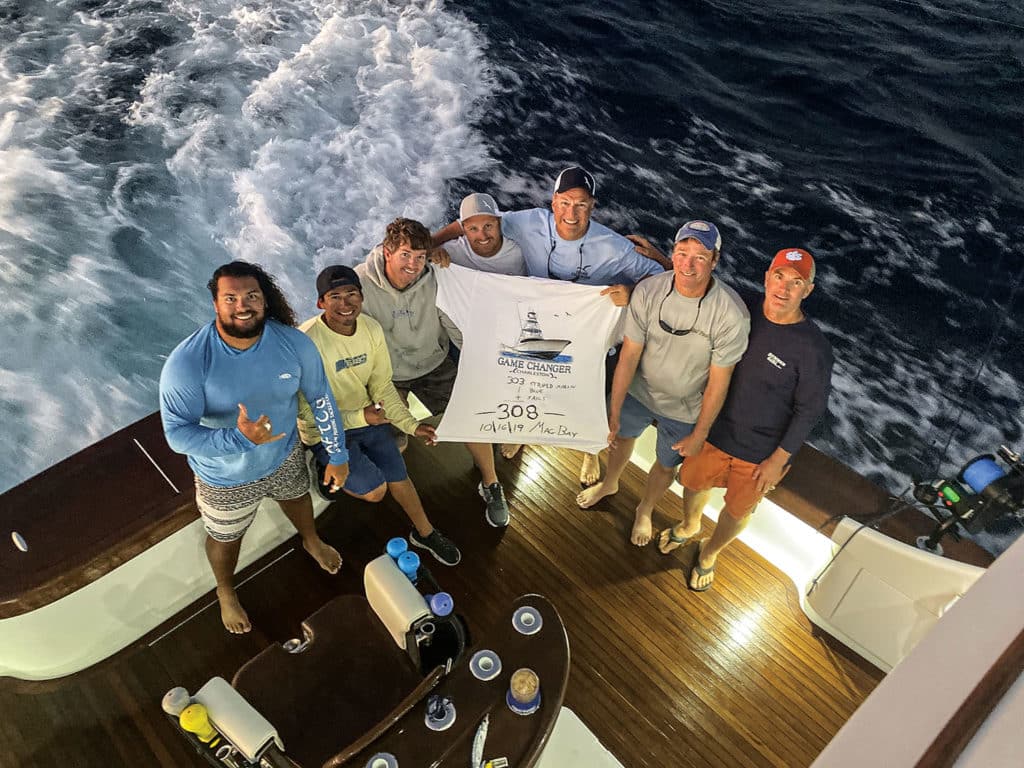
In the Zone
The bite came in fast flurries. The first angler to hook up would always be the last to score the release, as the boat went into a turn and the anglers hooked more fish through the turn. The team kept count, logging each flurry of releases. Their best of the day was releasing 19 marlin in a row without a break in the action. One of the anglers would release their fish, then Aiken or LaGrone would have a fresh rod and bait ready to hand them. It became a running joke to try to not be the first angler to hook up because two or three other fish could get released before yours.
LaGrone says that for most of the day, they got into a rhythm that was working so well—everything was just clicking—that he entered what he referred to as the zone, that from his explanation could be compared to a runner’s high: The senses relax as you become numb to the surroundings and you’re just there in the moment, operating at maximum capacity without even thinking about it. By this point, they had depleted nearly all of the 300 ballyhoo they had rigged the night before. It was then they thawed out the pre-rigged backup baits—the hangover bag, as it’s called.
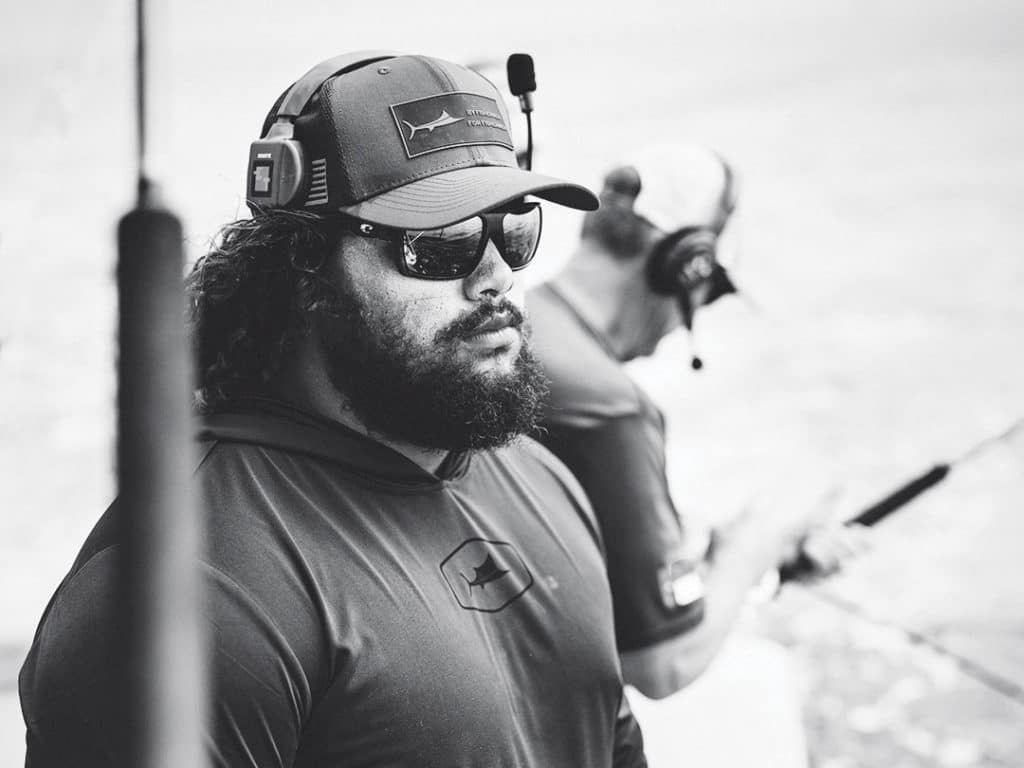
Incoming!
At one point in the afternoon, all three anglers were hooked up and fighting striped marlin—Lackey’s and Leasure’s fish were on the starboard side of the cockpit, and Faith was bringing a striped marlin up to the port side when his fish began greyhounding right toward the boat. When it got there, it didn’t slow down, but rather leaped in the air and flew over the transom toward the other two anglers, who were looking the other way.
Learn more about striped marlin here.
Lackey turned to his right and saw the marlin flying straight toward him, bouncing right over the fighting chair. He put out his hand like a fullback stiff-arming a defender in a futile attempt to stop its forward progress. The bill of the airborne marlin went right through the fingers of Lackey’s cramped hand and came to rest in the crook of his arm. Fortunately, his sleeves were pushed up, and the bill embedded in the bunched-up shirt material around his elbow, but the impact of the marlin was enough to knock him flat on his back in the cockpit, with the thrashing striped marlin right on top of him. The mates jumped to the rescue and pulled the marlin off Lackey, who then calmly stood up and continued fighting his fish on the rod, which he kept clutched in his left hand the entire time; he successfully released that fish a few minutes later. Lackey stepped into the salon for a minute to put a few Band-Aids on his arm and fingers, and then got right back to fishing. Meanwhile, Leasure’s blue Gatorade still sat waiting patiently in the cup holder.
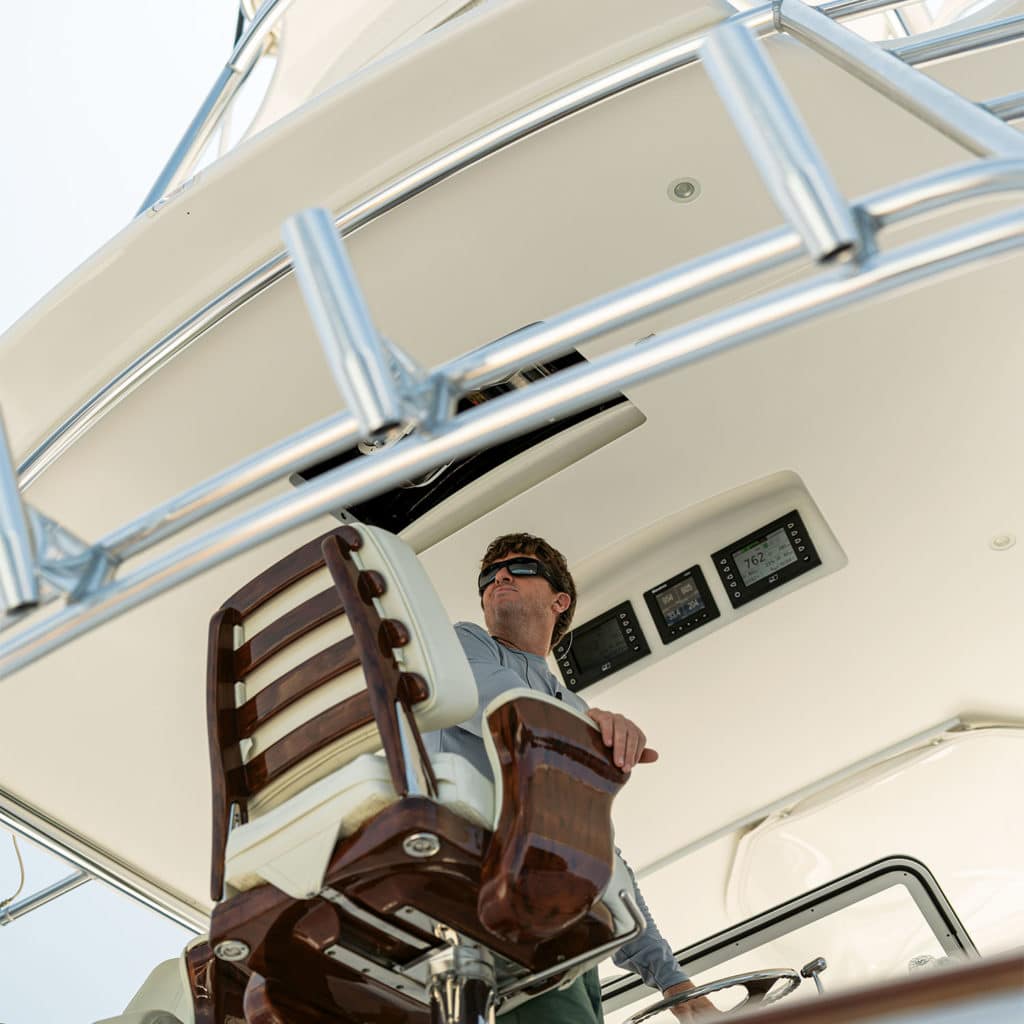
The Numbers Add Up
Polk was keeping count of all these fish with the help of the crew and anglers, marking them with the familiar one-through-five hash marks in his logbook. At 6:59 p.m., he added six new marks that confirmed they had broken into legendary and even hard-to-believe territory. They had released more than 300 billfish and then backed that up with three more striped marlin, to finish the incredible day with a tally of 303 striped marlin, four sailfish and one blue marlin. The sheer number of marlin they released was so far beyond reality, they were at a loss for words of how to describe it. They attributed their success to teamwork as well as having a bite like that all to themselves, plus the skill of Polk at the helm and the agility of the Bayliss platform. The team also offered their heartfelt thanks to the many captains and crews who pioneered the striped marlin fishery in southern Baja over the past 50 years. You don’t have to be in Mag Bay to experience some of the best billfish action you may ever see; there are plenty of well-equipped charter boats waiting for your call in Cabo.
One thing the team was clear about: They did not set out to break any kind of record other than their own personal best day. In the end, the decision to make good use of the time they spent waiting for the port to reopen by carefully rigging and then freezing the extra ballyhoo proved to be an incredibly fortuitous one that allowed them to maintain their rhythm of hooking and releasing fish throughout the afternoon. While they have always been referred to as hangover bags, I will call those frozen baits “game changers” from now on.







